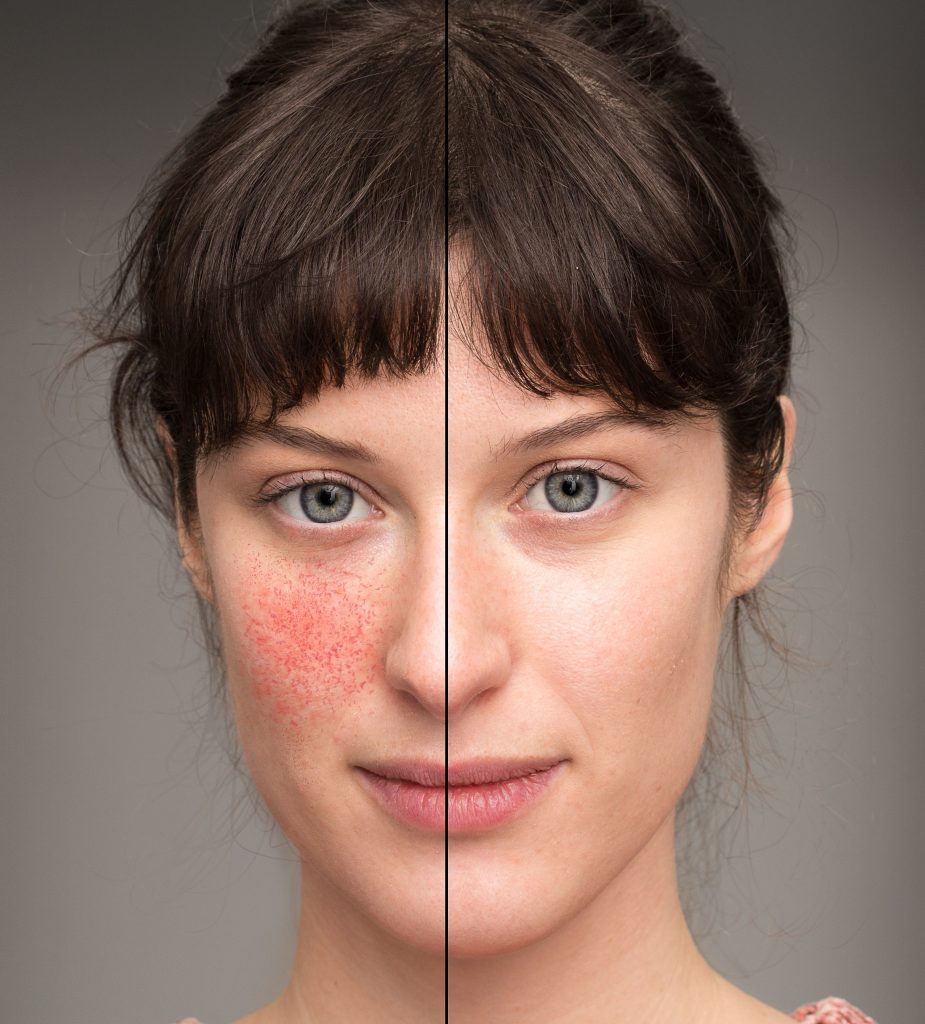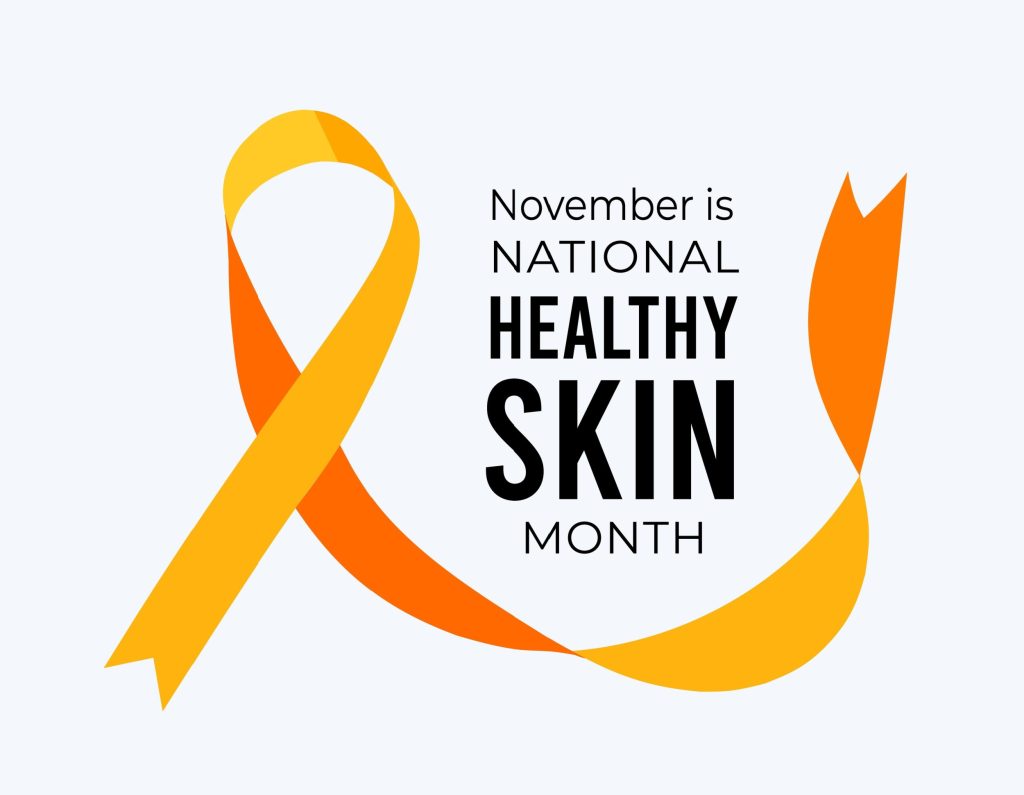
If you’ve recently been diagnosed with rosacea, you may be wondering about steps to take next. Rosacea is a common and chronic skin condition that affects millions of people worldwide. It can cause redness, visible blood vessels, and bumps on the face. While its exact cause is unknown, factors such as genetics, environmental triggers, and vascular abnormalities are believed to play a role. Rosacea typically appears on the central part of the face and can vary in severity from mild to severe.
If you’d like to understand more about how to manage rosacea effectively and how to navigate your lifestyle with this skin condition, here are five key things you need to know from a board-certified dermatologist’s point of view.
1. Common Symptoms of Rosacea:
Facial flushing: Persistent redness or flushing of the face, such as the cheeks, nose, forehead, and chin may be present.
Visible blood vessels: Small, visible blood vessels (telangiectasia) may appear on the skin, especially on the cheeks and nose.
Bumps and pimples: Small, red bumps resembling acne may develop on the face, often accompanied by stinging or burning sensations.
Thickening skin: In some cases, the skin on the nose may thicken and become bumpy, a condition known as rhinophyma.
Eye irritation: Ocular rosacea can cause symptoms such as redness, dryness, itching, burning, and sensitivity to light.
It’s important to note that symptoms can vary from person to person, and not everyone with rosacea will experience all of these symptoms. Additionally, symptoms may come and go in episodes known as flare-ups, which can be triggered by various factors, which are explained below.
2. Triggers of Rosacea:
Sun exposure: Ultraviolet (UV) rays from the sun can worsen rosacea symptoms, leading to increased redness and inflammation.
Hot beverages: Hot drinks such as coffee, tea, and hot cocoa can cause flushing and exacerbate rosacea symptoms.
Spicy foods: Foods containing spices such as chili peppers, black pepper, and curry can trigger flushing and increase redness in individuals with rosacea.
Alcohol: Alcohol, particularly red wine, beer, and hard liquor can dilate blood vessels and lead to facial flushing and worsening of rosacea symptoms.
Temperature extremes: Exposure to extreme heat or cold, such as saunas, hot baths, and cold weather, can trigger flushing and exacerbate rosacea.
Stress: Emotional stress and anxiety can trigger rosacea flare-ups and worsen symptoms.
Certain skincare products: Harsh or irritating skincare products containing alcohol, fragrances, or exfoliating ingredients can aggravate rosacea symptoms.
Wind: Windy conditions can irritate the skin and trigger flushing and redness in individuals with rosacea.
Exercise: Strenuous exercise and activities that cause sweating can lead to facial flushing and exacerbate rosacea symptoms.
Medications: Certain medications, such as corticosteroids and blood pressure medications, can worsen rosacea symptoms as a side effect.
It’s important for individuals with rosacea to identify their personal triggers and take steps to avoid or minimize exposure to them to help manage their symptoms effectively. Keeping a journal to track flare-ups and triggers can be helpful in identifying patterns and making lifestyle adjustments accordingly.
3. Treatment Options for Rosacea:
The most common treatment options for rosacea include:
Topical medications: These types of treatments are often prescribed to reduce redness, inflammation, and acne-like bumps associated with rosacea. You may be prescribed something like metrogel, azelaic acid, sulfur, or something similar.
Oral antibiotics: Oral antibiotics, such as tetracycline, doxycycline, minocycline, and erythromycin, are commonly prescribed to control inflammation and reduce papules and pustules associated with rosacea.
Oral anti-inflammatory medications: In some cases, oral medications such as low-dose oral isotretinoin (Accutane) may be prescribed to help control severe cases of rosacea.
Laser therapy: Laser and light-based treatments can target blood vessels and reduce redness associated with rosacea. These treatments may include intense pulsed light therapy, pulsed dye laser therapy, or fractional laser therapy.
Dermabrasion: Dermabrasion is a procedure that involves removing the top layer of skin to reduce the appearance of thickened skin and bumps associated with rosacea, particularly in cases of rhinophyma.
Eye drops: For individuals with ocular rosacea, lubricating eye drops, or prescription medications may be prescribed to relieve dryness, redness, and irritation in the eyes.
Lifestyle modifications: Making lifestyle changes and avoiding triggers can help manage rosacea symptoms. This may include using gentle skincare products, wearing sunscreen daily, avoiding triggers such as sun exposure, hot beverages, spicy foods, and stress, and managing stress through relaxation techniques or therapy.
Moisturizers: Using gentle, fragrance-free moisturizers can help soothe and hydrate the skin, reducing dryness and irritation associated with rosacea.
It’s important for people with rosacea to work closely with a dermatologist to develop a personalized treatment plan tailored to their specific symptoms and needs. Treatment may involve a combination of medications, procedures, and lifestyle modifications to effectively manage rosacea symptoms and improve the overall quality of life.
4. Priorities When Having Rosacea:
Handle your skin with care and make moisturizing a daily habit.
Choose mild, fragrance-free cleansers: Opt for gentle cleansers specifically formulated for sensitive skin to avoid irritation and inflammation.
Moisturize daily: Use a gentle, non-comedogenic moisturizer to hydrate the skin and maintain its barrier function, reducing dryness and irritation.
Avoid harsh exfoliants: Steer clear of abrasive scrubs and exfoliating products that can exacerbate redness and inflammation in rosacea-prone skin.
Patch test new products: Before using a new skincare product, perform a patch test on a small area of skin to check for any adverse reactions or sensitivity.
Protect your skin from the sun: Apply a broad-spectrum sunscreen with SPF 30 or higher daily to shield your skin from harmful UV rays, which can trigger rosacea flare-ups.
5. Keep an Eye on Your Skin:
You are your own best advocate for your skin. You see it every day and know it better than anyone else. Because of this, you should watch for new changes with your rosacea and report them to your dermatologist.
Persistent redness: If you notice that the redness in your skin is becoming more intense or widespread and does not improve with treatment, it could indicate worsening rosacea or the development of a complication.
Pimples or bumps: While acne-like bumps are common in rosacea, new or worsening papules and pustules may signal an exacerbation of the condition or the need for a change in treatment.
Changes in texture of the skin: Thickening of the skin can be a normal symptom of rosacea, however, any changes in skin texture or appearance should be evaluated by a dermatologist.
Eye symptoms: If you experience eye irritation, redness, dryness, or sensitivity to light, it could indicate ocular rosacea. Prompt evaluation and treatment are essential to prevent complications and preserve eye health.
New or unusual symptoms: Any new or unusual symptoms, such as burning, stinging, itching, or tingling sensations, should be reported to your dermatologist, as they may indicate an underlying issue or complication.
Side effects of treatment: If you experience any adverse reactions or side effects from your rosacea treatment, such as increased redness, irritation, or allergic reactions, inform your dermatologist immediately for appropriate management.
Overall, it’s essential to stay vigilant about changes in your skin and seek prompt medical attention if you notice any concerning symptoms or developments. Early detection and intervention can help effectively manage rosacea and prevent complications.
We understand that being diagnosed with rosacea can feel daunting, but if you are armed with knowledge and support, you can effectively manage this skin condition and minimize its impact on your life. Remember to prioritize your skincare, sun protection, and avoiding triggers while seeking professional guidance from a dermatologist. With the right approach, you can navigate life with rosacea with confidence and control.
Contact FLDSCC for All Your Skin Care Needs
Florida Dermatology and Skin Cancer Centers provides a full spectrum of dermatology and skin care services, and its team of physicians, APRNs, and PAs are experts in diagnosing and treating skin cancers with the latest technological options. Medical Director, Dr. K. Wade Foster, is fellowship-trained in Mohs surgery, the most effective technique for most types of skin cancers, with minimal scarring or risk.
For more information about the services that Florida Dermatology and Skin Cancer Centers provides, or to make an appointment for a skin exam, visit https://fldscc.com/or contact us at (855) FLD-SKIN.


